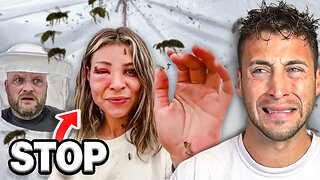Premium Only Content

A Glimpse into the World of Deer
The life of a deer, often referred to as a whitetail deer in North America, is fascinating and well-adapted to its natural habitat. Here's a description of the life of a deer:
Habitat: Deer are versatile animals that can be found in a variety of habitats worldwide, including forests, grasslands, swamps, and even suburban areas. They are especially common in North America.
Diet: Deer are herbivores, primarily feeding on plants. They graze on grasses, leaves, twigs, and fruits. During winter, when vegetation is scarce, they may also browse on woody shrubs and tree bark.
Social Structure: Deer often live in small family groups or are solitary animals, depending on the species and their age. In the case of whitetail deer, you can find family groups of does (females) and their fawns, while bucks (males) are more solitary but may form small bachelor groups.
Reproduction: Deer have a seasonal breeding cycle called the rut. During this time, males compete for the attention of females by displaying their antlers and engaging in territorial behavior. After mating, female deer typically give birth to one to three fawns in the spring or early summer, depending on the species and region.
Antlers: Male deer grow and shed their antlers annually. Antlers serve as both weapons during the rut and displays of dominance. They start growing in the spring and reach full size by late summer or early fall. Antlers are then shed in the late winter or early spring and regrow.
Predators: Deer have several natural predators, including wolves, mountain lions, coyotes, and bobcats. They use their keen senses of smell, hearing, and agility to avoid or escape from predators.
Migration: Some deer species, such as the mule deer, engage in seasonal migrations. They move between higher-elevation summer ranges and lower-elevation winter ranges to find food and avoid harsh weather conditions.
Adaptations: Deer have several adaptations to help them survive in the wild, including keen senses, such as excellent hearing and night vision, to detect threats. Their cryptic coloration and ability to freeze or flee make them challenging to spot in the wild.
Human Interaction: Deer are often hunted for their meat and hides, and they are also subject to vehicle collisions, especially in areas where urban development encroaches on their habitat.
Conservation: Deer populations are carefully managed in many regions to maintain a balance between their numbers and available resources. This helps ensure their survival and the health of the ecosystems they inhabit.
The life of a deer is a constant struggle for survival in the wild, shaped by their evolutionary adaptations and their interactions with their environment and other species, including humans.
-
 14:08
14:08
Forrest Galante
6 hours agoPrivate Tour Of the World's Most Expensive Pet Show
49K4 -
 13:50
13:50
Nikko Ortiz
16 hours agoStop Hurting Yourself For Views.
4.8K3 -
 2:07:06
2:07:06
Side Scrollers Podcast
1 day agoDiaper Furry Streamer Gets ONLY ONE DAY Suspension + Hasan PLAYS VICTIM + More | Side Scrollers
31.4K19 -
 56:38
56:38
DeProgramShow
1 day agoDeprogram with Ted Rall and John Kiriakou: "Jake Tapper on the Global Hunt for an Al Qaeda Killer”
4.25K3 -
 1:43:07
1:43:07
The Michelle Moore Show
2 days ago'The 12 Open Doors' Guest, Steve Jarvis: The Michelle Moore Show (Oct 17, 2025)
12.9K10 -
 LIVE
LIVE
Lofi Girl
3 years agolofi hip hop radio 📚 - beats to relax/study to
96 watching -
 1:45:06
1:45:06
Badlands Media
23 hours agoDevolution Power Hour Ep. 399: No Kings, Antifa’s Collapse & Trump’s Year of Peace
276K84 -
 2:56:00
2:56:00
Laura Loomer
10 hours agoEP150: New Yorkers Brace For Islamic Takeover After Mayoral Election Debate
81.5K98 -
 1:35:37
1:35:37
Man in America
14 hours agoThe Forbidden Medicine of Light: Why is Big Pharma HIDING This From Us?
61.6K23 -
 2:35:13
2:35:13
BlackDiamondGunsandGear
7 hours agoAFTER HOURS ARMORY / BUILDING GUNS ARE ILLEGAL? / Marine Gun Builder RETURNS!!
22.3K3